Related Research Articles

Our Lady of Fátima is a Catholic title of Mary, mother of Jesus, based on the Marian apparitions reported in 1917 by three shepherd children at the Cova da Iria in Fátima, Portugal. The three children were Lúcia dos Santos and her cousins Francisco and Jacinta Marto. José Alves Correia da Silva, Bishop of Leiria, declared the events worthy of belief on 13 October 1930.

Our Mother of Perpetual Succour is a title of the Mary, mother of Jesus in Catholicism associated with a 15th-century Byzantine icon and a reputed Marian apparition. The image has been enshrined in the Church of San Matteo in Via Merulana since 27 March 1499, and is today permanently enshrined in the Church of Saint Alphonsus of Liguori in Rome, where the novena to Our Mother of Perpetual Help is prayed weekly.

The Immaculate Heart of Mary is a Roman Catholic devotion which refers to the view of the interior life of Mary, her joys and sorrows, her virtues and hidden perfections, and, above all, her virginal love for God the Father, her maternal love for her son Jesus Christ, and her motherly and compassionate love for all mankind. Traditionally, the Immaculate Heart is depicted pierced with seven swords or wounds, in homage to the seven dolors of Mary and roses, usually red or white, wrapped around the heart.

Our Lady of Aparecida, is a title of the Blessed Virgin Mary associated with the Immaculate Conception.
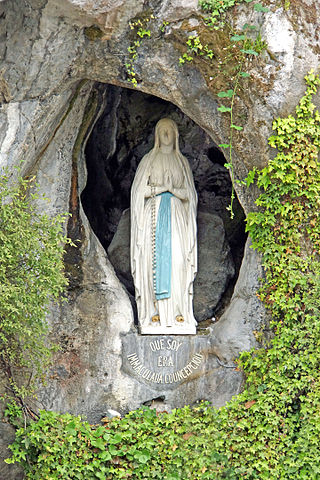
Our Lady of Lourdes is a title of the Virgin Mary. She is venerated under this title by the Roman Catholic Church due to her apparitions that occurred in Lourdes, France. The first apparition of 11 February 1858, of which Bernadette Soubirous told her mother that a "Lady" spoke to her in the cave of Massabielle while she was gathering firewood with her sister and a friend. Similar apparitions of the "Lady" were reported on 18 occasions that year, until the climax revelation in which she introduced herself as: "I am the Immaculate Conception". On 18 January 1862, the local Bishop of Tarbes Bertrand-Sévère Laurence endorsed the veneration of the Blessed Virgin Mary in Lourdes.

In Christian theology, a private revelation is an instance of revelation, in a broader sense of the term, of divine reality to a person or persons. It contrasts with revelation intended for humanity at large, which is sometimes termed public revelation.
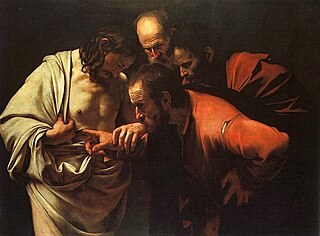
A number of people have claimed to have had visions of Jesus Christ and personal conversations with him. Some people make similar claims regarding his mother, Mary. Discussions about the authenticity of these visions have often invited controversy. The Catholic Church endorses a fraction of these claims, and various visionaries it accepts have achieved beatification, or even sainthood.

Mary, the mother of Jesus in Christianity, is known by many different titles, epithets, invocations, and several names associated with places.

Our Lady of Kibeho, also known as Our Lady of Sorrows of Kibeho, is a Catholic title of the Mary, mother of Jesus, based on the Marian apparitions reported in the 1980s by several adolescents in Kibeho, south-western Rwanda. The young visionaries were Alphonsine Mumureke, Nathalie Mukamazimpaka and Marie Claire Mukangango.

The Mariology of the popes is the theological study of the influence that the popes have had on the development, formulation and transformation of the Roman Catholic Church's doctrines and devotions relating to the Blessed Virgin Mary.

The veneration of Mary in the Catholic Church encompasses various devotions which include prayer, pious acts, visual arts, poetry, and music devoted to her. Popes have encouraged it, while also taking steps to reform some manifestations of it. The Holy See has insisted on the importance of distinguishing "true from false devotion, and authentic doctrine from its deformations by excess or defect". There are significantly more titles, feasts, and venerative Marian practices among Roman Catholics than in other Western Christian traditions. The term hyperdulia indicates the special veneration due to Mary, greater than the ordinary dulia for other saints, but utterly unlike the latria due only to God.
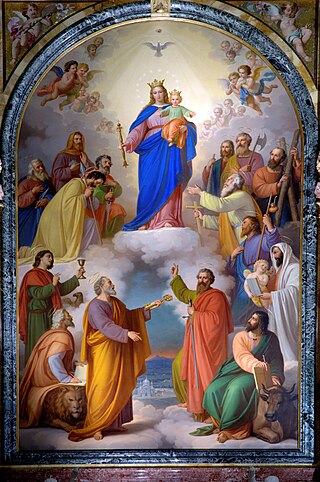
Mary, the Help of Christians, is a Roman Catholic title of the Blessed Virgin Mary, based on a religious devotion now associated with a feast day of the General Roman Calendar on 24 May.
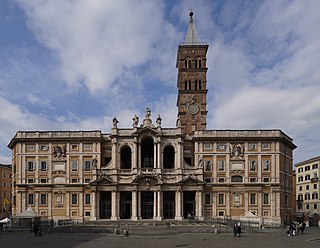
Catholic Marian churches are religious buildings dedicated to the veneration of the Blessed Virgin Mary. These churches were built throughout the history of the Catholic Church, and today they can be found on every continent including Antarctica. The history of Marian church architecture tells the unfolding story of the development of Catholic Mariology.

Medjugorje, a village in the south of Bosnia and Herzegovina, has been the site of alleged apparitions of the Blessed Virgin Mary since 24 June 1981. Various officials of the Catholic Church have attempted to discern the validity of these Marian apparitions in order to provide guidance to potential devotees and pilgrims. On 7 December 2017, it was reported that Archbishop Hoser, Pope Francis' envoy to Medjugorje, announced that official pilgrimages are allowed, stating, "dioceses and other institutions can organize official pilgrimages." This pilgrimage was officially authorized by the Holy See in May 2019. The approval was not intended to signify recognition of the apparitions, but acknowledge the faith and pastoral needs of the pilgrims.

The consecration and entrustment to the Virgin Mary is a personal or collective act of Marian devotion among Catholics, with the Latin terms oblatio, servitus, commendatio and dedicatio being used in this context. Consecration is an act by which a person is dedicated to a sacred service, or an act which separates an object, location or region from a common and profane mode to one for sacred use. The Congregation for Divine Worship and the Discipline of the Sacraments clarifies that in this context, "It should be recalled, however, that the term "consecration" is used here in a broad and non-technical sense: the expression is use of 'consecrating children to Our Lady', by which is intended placing children under her protection and asking her maternal blessing for them".
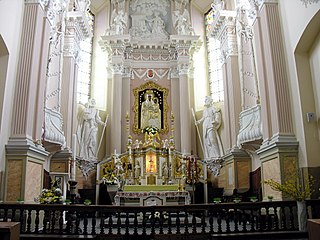
Our Lady of Šiluva is Roman Catholic image of the Blessed Virgin Mary venerated at the Basilica of the Nativity of the Blessed Virgin Mary, Šiluva shrine in Lithuania. The patriotic icon is highly venerated in Lithuania and is often called Lithuania's greatest treasure.

Our Lady of the Rosary of San Nicolás is, in Catholicism, a title of veneration of the Blessed Virgin Mary associated with a reported private revelation to Gladys Quiroga de Motta, a middle-aged housewife, beginning in the 1980s in the city of San Nicolás de los Arroyos, Argentina. Quiroga said that she was tasked with promoting devotion to the Mother of God under this title, with an emphasis on key passages in the Bible and a particular mystical stellar symbolism.

Our Lady of Consolation or Mary, Comforter of the Afflicted is a title of the Blessed Virgin Mary venerated in the Roman Catholic Church.
References
- ↑ EWTN: Judgment on the Apparitions of Kebeho "The recognition or negation of the authenticity of an apparition does not guarantee infallibility; it is based on proofs of probability more than on apodictic arguments". In the sphere of the apparitions there is then no absolute certainty for the witnesses, except perhaps for the visionary.
- ↑ Norms regarding the manner of proceedings in the discernment of presumed apparitions or revelations, 2...to achieve with the required speed the judgments that in the past concluded the investigation of such matters (constat de supernaturalitate, non constat de supernaturalitate)...
- ↑ Verbum Domini, 14 Ecclesiastical approval of a private revelation essentially means that its message contains nothing contrary to faith and morals; it is licit to make it public and the faithful are authorized to give to it their prudent adhesion.
- ↑ Code of Canon Law, Can. 1230 By the term shrine is understood a church or other sacred place to which numerous members of the faithful make pilgrimage for a special reason of piety, with the approval of the local ordinary.
- ↑ Code of Canon Law, Can. 1244 It is only for the supreme ecclesiastical authority to establish, transfer, and suppress feast days and days of penance common to the universal Church, without prejudice to the prescript of can. 1246, §2. Diocesan bishops can decree special feast days or days of penance for their dioceses or places, but only in individual instances.
- ↑ Directory on Popular Piety and the Liturgy, n. 90, 230, 263 Popular piety has always been interested in extraordinary happenings and events that are not infrequently connected with private revelations. While not confined to Marian piety alone, this phenomenon is particularly involved with "apparitions" and "messages"...Both the Liturgy and popular piety attach great importance to the feast days assigned to the Saints. The "Saint's day" is marked with numerous cultic displays, some liturgical, others deriving from popular piety...To the faithful, shrines represent a memorial to an original extraordinary event which has given rise to persistent devotion, or a witness to the piety and gratitude of a people that has received many benefits
- ↑ Bishop Jean-Michel de Falco, May 5, 2008
- ↑ Bishop David Ricken, Decree on the Authenticity of the Apparitions of 1859
- ↑ Bishop Augustin Misago, Approval of the Apparitions of the Blessed Virgin Mary at Kibeho
- ↑ Pope Pius XI, Miserentissimus Redemptor n. 12
- ↑ Pope John Paul II, Dedication of the Shrine of Divine Mercy n. 5
- ↑ Pope Benedict XVI, September 29, 2010 General Audience
- ↑ Pope Benedict XVI, October 6, 2010 General Audience
- ↑ Pope John Paul II, Basilica of Our Lady of Guadalupe
- ↑ Pope Pius XII, Le Pelerinage de Lourdes n. 9
- ↑ Pope Pius XII, Le Pelerinage de Lourdes n. 9
- ↑ Pope John Paul II, Beatification of Francisco and Jacinta n. 3
- ↑ Pope John Paul II, Visit to the Shrine of Knock

